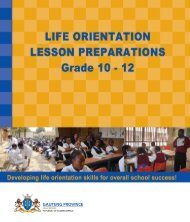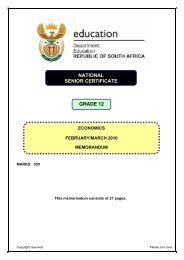Life Science Grade 11
Life Science Grade 11
Life Science Grade 11
Create successful ePaper yourself
Turn your PDF publications into a flip-book with our unique Google optimized e-Paper software.
<strong>Grade</strong> <strong>11</strong> <strong>Life</strong> <strong>Science</strong>s Lesson PlansGRADE <strong>11</strong> SUBJECT <strong>Life</strong> <strong>Science</strong>s WEEK 5 TOPIC Plant Groups: ngiosperms Lesson 2 & 3LESSON SUMMARY FOR: DATE STARTED:LESSON OBJECTIVESDATE COMPLETED:Content: (p 14 Assessment Syllabus)DIVERSITY, CHANGE AND CONTINUITY PLANT DIVERSITYPlant Groups• Angiosperms: vascular tissue, true leaves and roots, seeds, fertilization independent of water, produce flowers; seed is enclosed in a fruit.Introduction:The learners will be able to:• Distinguish between a moss, fern, gymnosperm and angiosperm with respect to structure of macroscopic plant, presence or absence of vasculartissue, dependence on water for fertilization, presence or absence of flowers, seed or spores.TEACHER ACTIVITIES LEARNER ACTIVITIES TIMING RESOURCES NEEDED1. Whole class discussion, group work discussion on various plant groups, individual work.1.1 IntroductionPlace learners in small groups of about 4 learners in a group. Provide each group with diagramsof a moss, fern, and gymnosperm, ask learners to name the group the plant belongs to. Recapalso on whether the plant is a thallus plant, whether they need water for reproduction, areseeds or spores produced?2.2 Main Body (Lesson presentation)Explain to learners that plants which bear flowers belong to the Angiosperms. The angiospermsare divided into two groups the monocotyledons and the dicotyledons, we will look at thedifferences between these two groups later in the lesson. Now we need to consider how theAngiosperms differ from the Bryophytes, Pteridophytes and Gymnosperms.Learners to decide which diagramis a moss, fern or gymnosperm andthen to list the variouscharacteristics which apply toeach plant group.Whole class teaching.15 min5 minDiagrams/photos of amoss plant, fern plant andgymnosperm.Solutions for allp58,60,61,62Study and Masterp90,p93,p96Understanding <strong>Life</strong><strong>Science</strong>s p56, p57, p60Have learners page to the front of their notebooks and look at the anatomy of a dicot root andstem. Learners are to find the xylem and phloem tissue.Learners to draw and label a diagram of an angiosperm (monocot or dicot it doesn’t matter)as well as a flower (monocot or dicot it doesn’t matter).Briefly outline the life cycle of an angiosperm, paying particular attention to fertilization beingindependent of water, the formation of a seed. Seeds often occurring inside fruits. Thesignificance of the production of seeds (allow for a dormant state, different types of seeds arestructurally suited to allow for a particular mode of dispersal. Fruits are used usually to attractanimals for the purpose of seed dispersal.)Learners find the T/S through adicot root and stem and locate thexylem and phloem tissueLearners draw and label a diagramof an angiosperm plant, including aflower and fruit.Learners to draw and label adiagram of a flower and a diagramof the life cycle of an angiospermplant.10 min20 minLearners to write down advantages10 minSolutions for all p64-65Term 1 Page 36© Gauteng Department of Education (CAPS version)







